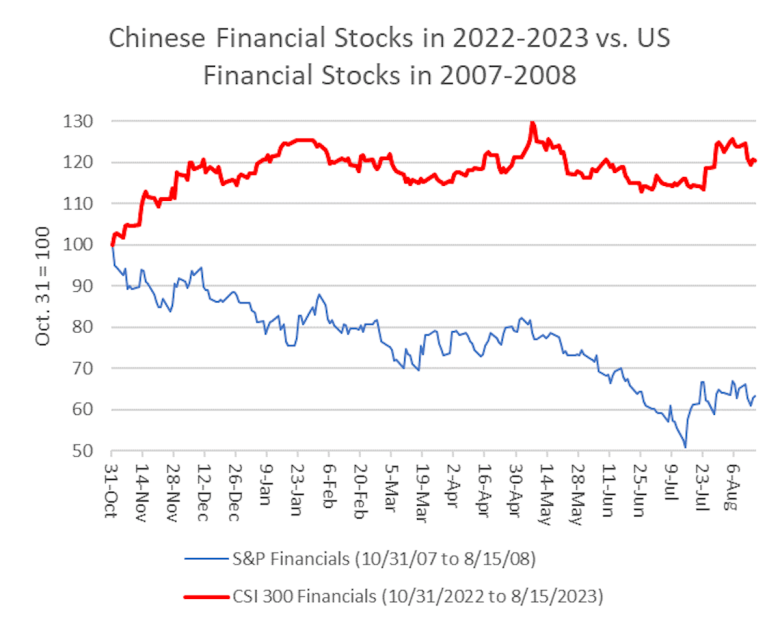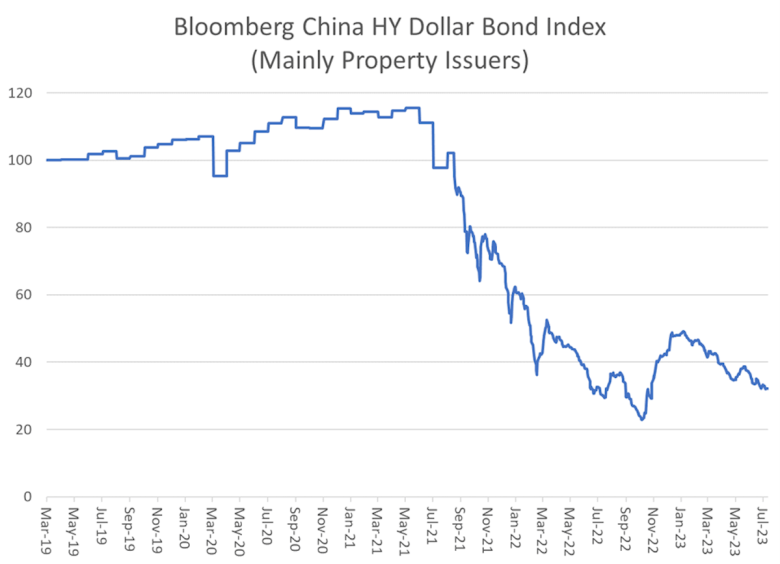
Comparing the shakeout of China’s property sector to America’s Great Financial Crisis of 2008 has become a popular meme in the commentariat. Stock markets don’t see it that way: During the 10 months from November through August in 2008, US financial stocks lost half their market value, while Chinese financial stocks have gained 20 percent.
The chart below compares the S&P’s Financials sub-index in the leadup to the GFC (October 31, 2007, through August 15, 2008) to the performance of the financials sub-index of the Shenzhen 300 Index during the same months of 2022-2023.

There is no systemic crisis in China, which has no subprime market, no 5% down mortgages and no “liar’s loans” – the toxic ingredients of America’s toxic 2008 crisis.
China has a different sort of problem: The migration of nearly 700 million Chinese from countryside to city produced history’s greatest land boom, and allowed local governments to fund themselves and their friends with land sales. Real estate ballooned to a quarter of China’s GDP, and lazy capital flowed into the property market.
China’s marginal efficiency of capital (GDP growth per unit of gross fixed capital formation) fell from 0.3% in the 1990s to only .15% in 2020. That’s what Beijing is determined to change.
Xi Jinping’s government in Beijing began tightening lending standards for the property market in 2020, pushing property developers into distress by the middle of 2022. China’s top developers, Evergrande and Country Gardens, have failed to make bond payments. Some trust products – high-interest paper issued by financial institutions with backing by IOUs from property developers and others – have defaulted.

Policy analysts with access to the State Council told Asia Times in Beijing last week that the property market crisis is political.
“Common prosperity” and “Houses are for living, not for speculation” are the populist slogans that the government has put forward, but the underlying issue is simpler: Xi Jinping wants to centralize government finances and impose fiscal discipline on local governments that have lived off the windfall of land prices for the past thirty years.
The central government could push a button and stop the bleeding in the property market whenever it wants. But it won’t let a good crisis go to waste, in Rahm Emmanuel’s phrase.
The State Council is determined to steer China toward a high-tech economy with high rates of return on capital and strong productivity growth, and it will keep the squeeze on the lazy capital of the property market until its political redoubts have been reduced.
To put China’s financial problems in context: There are between RMB 35 trillion and 70 trillion in off-the-books government financing through local government financing vehicles (LGFVs) and other instruments, according to the International Monetary Fund.
Assume an RMB 50 trillion float and an extreme 20% default rate, or RMB 10 trillion of nonpaying bonds. At the current yield of quasi-governmental bonds, that’s RMB 250 billion in skipped coupon payments, or about 1% of China’s central government revenues in 2022.
In an extreme hypothetical case of mass local government defaults, the cost of transferring the cost of debt service to the central government would be trivial compared with overall government revenues.
State-owned enterprises belonging to local governments have estimated assets of about RMB 210 trillion, which can be sold over time to pay down debt. Even assuming a significant drop in property prices, SOE assets more than cover local government debt.
Compare this with the 2008 crisis in the United States, where the market value of about $2 trillion in securitized mortgages and home equity loans fell by more than half, leaving the banks insolvent on a mark-to-market basis.
Regulatory forbearance (ignoring the mark-to-market losses) allowed the banks to work their way out of the hole. Most of the securitized paper continued to pay coupons, and allowed banks to continue to pay interest on the liabilities that funded them.
Mortgage balances in China amount to less than 40% of the value of the financed property, according to the International Monetary Fund. Compare this with the United States in 2008, where the average loan-to-value ratio for conventional single-family mortgages was close to 80%, and nearly 30% of newly-issued mortgages had loan-to-value ratios of more than 90%.
US banks issued 5% down mortgages, zero-interest mortgages, and other highly-levered forms of financing that left homeowners without a cushion when the housing market imploded.
Despite these enormous differences, US think tanks draw parallels to the 2008 crisis. A recent Council on Foreign Relations report states:
A PBoC survey of urban households conducted in 2019 revealed that the value of housing composed 59 percent of households’ total assets, while mortgage loans stood at 12 percent of total assets. These figures are similar to the United States in 2008 on the eve of the subprime mortgage crisis.
That’s true, but misleading: China has no subprime market. It has a small fraction of mortgages issued with a 20% down payment, and an average equity cushion of about 60%.
On Aug. 16, the LGFV market passed a critical test when Tianjin Infrastructure Construction Group sold a RMB 1.5 billion 4.5% six-month note with bids 70 times the offering volume. Bloomberg called this “a sign that Beijing’s fresh efforts to defuse debt risks among regional authorities are reviving demand for such securities.”
Tianjin is the site of China’s first fully-automated port, a marvel of AI applications, and may be a special case, but the takeaway is that the LGFV market remains in full function.
The financial war of attrition between local governments and Beijing will depress China’s GDP growth in the short term, and keep private capital investment subdued for the time being. In an August 14 note to clients, JP Morgan analyst Katherine Lei wrote:
Our base case assumption is that real estate investment will decline by 7.5% in 2023 (vs -10% in 2022) and GDP growth will be 5.0% in 2023. However, the implications of the default events by Country Garden and trusts may be higher than suggested by all the headline estimates.
Some Wall Street analysts recommend taking profits on Chinese bank stocks, worrying that the big state-owned banks might be asked to step in and bail out developers, local government paper or trust products.
That would imply reduced bank profits, but by no means systemic problems for the banks. The volume of interest payments at risk is small relative to the cash flow of the Chinese government.






